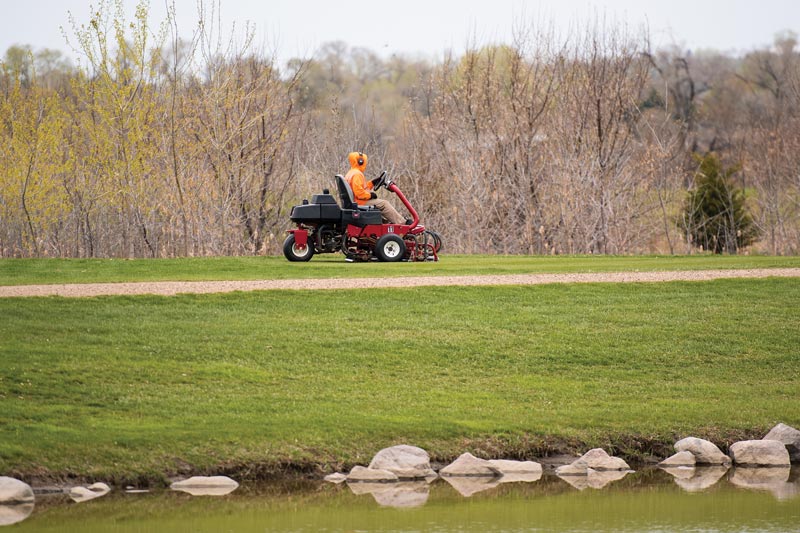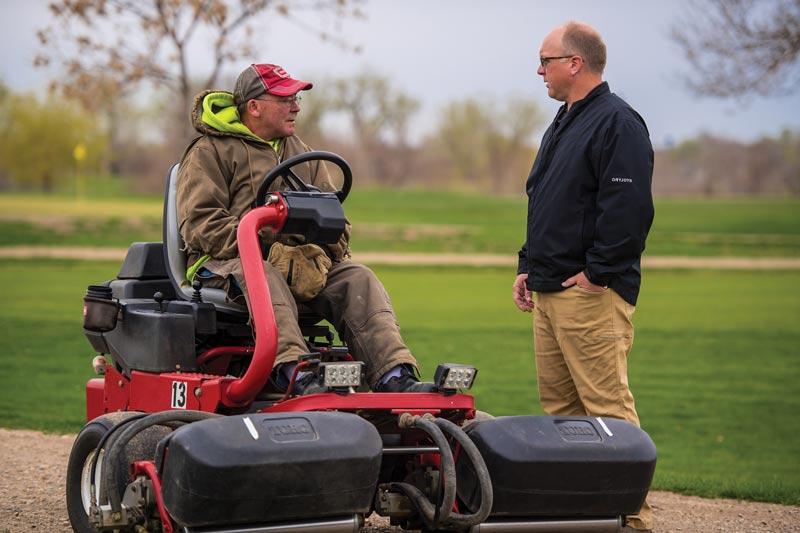
Bryan Tipton, CGCS, superintendent at Hillsview Golf Course in Pierre, S.D., has employed a total of eight inmates from the South Dakota Women’s Prison on his maintenance crew since August 2017. Photo by Studio 212 Photography
There was healing and solace in the fresh air and open sky, and even in the weeds. Out working on the 150 acres of Hillsview Golf Course in Pierre, S.D., a weed eater in her hands, Kari’s grief would lift for a little while.
“My mom loved everything about being outside. She loved to mow, loved to trim trees — and she hated weeds,” says Kari, whose mom died in 2017 during Kari’s 23-month incarceration at the South Dakota Women’s Prison in Pierre. “Being on the golf course was therapeutic for me. I felt like I was really close to her.”
Kari’s opportunity to work in golf course maintenance was the product of a partnership between Hillsview Golf Course and the South Dakota Department of Corrections. At the helm is Hillsview superintendent Bryan Tipton, CGCS, who, in looking for help with a sudden staffing shortage, found a source of consistent, hardworking crew members who’ve equipped his department to accomplish more and also reduced the golf course’s labor expenses.
Since 2017, two to three inmates from the women’s prison — located about half a mile from Hillsview’s entrance — have worked for Tipton full time. The women’s job duties at the 18-hole municipal course include everything from mowing tees and raking bunkers to shoveling snow and deep-cleaning the maintenance building. “It would be easier to describe the things they don’t do,” says Tipton, a 23-year GCSAA member.
Tipton has been able to eliminate seasonal positions and fill the voids with year-round DOC workers, a swap that saved the golf course about $17,000 in 2018. The additional hands on deck have also enabled Tipton to check more items off his to-do list. “The first winter the inmates worked, we did a lot of tree work and removed over 40 tons of deadwood and trees,” Tipton says. “We wouldn’t have been able to do that without the DOC workers.”
The collaboration has fostered savings, productivity and, for Kari, a life-changing experience. “Bryan was a huge morale booster for me in how he treated us and how he believed in us,” says Kari, 42, who finished her prison sentence last November and has since landed a part-time position on the maintenance crew at another golf facility. “Having someone believe in you and trust you after all the things you’ve been through — that’s really big for people like me.”
Help wanted
Tipton took the reins at Hillsview in February 2017, having previously tended nine-hole Colby (Kan.) Country Club and growing-in three courses: nine-hole Oahe Trails Golf Course in Pierre, S.D.; 27-hole Sutton Bay Golf Club in Agar, S.D.; and 18-hole Eagle Ridge Golf Club in Williston, N.D. Tipton’s résumé also included a stretch as agriculture program specialist for the South Dakota Department of Agriculture in Pierre, where he managed the state’s pesticide program from 2008 to 2017. That post was where he first encountered the idea of workers from the department of corrections, who were employed in various divisions of local and state government.

The city of Pierre, S.D., operates Hillsview Golf Course, which sits just east of the Missouri River in central South Dakota. The course was built in 1965 and has bentgrass greens, bluegrass tees and fairways, and bluegrass/fescue roughs. Photo by Studio 212 Photography
A South Dakota native, Tipton returned to golf course management to fill the shoes of Hillsview’s superintendent, whose retirement coincided with the departure of the course’s assistant superintendent and irrigation technician. Hillsview — where the golf season is typically March through mid-November — has four full-time employees, so Tipton was essentially tasked with building a team from scratch. The seven seasonal crew member positions proved the toughest to hire. “The ability to find workers besides college students here is pretty lacking,” Tipton says of Pierre, which has a population of roughly 14,000.
Tipton assembled a seasonal crew that consisted of college students and retirees, and all went relatively smoothly that first season at Hillsview. That is, until the students headed back to school mid-August, leaving Tipton short-handed with much golf left to be played.
“In Pierre, we’re semi-arid and warm, and we can have 80-degree weather all the way until November,” Tipton says. “So it’s really difficult to get through August, September and October without having a full staff. The golf course really suffers from that. You’re still getting the same amount of play, and you want to have quality conditions, but if you don’t have the workers, you can’t have those conditions.”
Knowing Pierre’s labor pool would be scant and remembering the inmates on the clock at the department of ag, Tipton reached out to the DOC on Aug. 18, 2017, to inquire about bringing some of the women’s prison workforce on board. Four days later, three inmates were at Hillsview bright and early, ready to join Tipton’s crew. Kari was part of that first group. “The day we got there, it had rained 4 inches the night before, and they were pumping out bunkers,” Kari says. “Bryan just threw us right in.”
Beyond bars
The inmates who work at Hillsview are minimum-security, meaning they’re classified as low-risk and are allowed to enter the community through work programs. At the South Dakota Women’s Prison in Pierre — the only women’s prison in the state — minimum-security inmates are carefully selected for their jobs by a coordinator who knows each woman’s background and matches them with the employment opportunity in which they’re most likely to excel.
“Institutionally, we can put them in the kitchen or we can put them in the laundry department; we can have them mow and do things around the building. But there’s just nothing like working out in the community alongside your neighbors,” says Darwin Weeldreyer, director of community service for the South Dakota Department of Corrections. “Our goal is to get inmates in a pro-social working environment that allows them to build a good work ethic and work alongside people who are good, law-abiding people.”
Editor’s note: This story piqued the interest of CBS Sports, and the network visited Hillsview Golf Course in September 2019 to film a segment on the topic, which aired during the 2020 PGA Championship. Watch it here:
Throughout Pierre, inmates hold jobs at places such as food banks, thrift stores and government offices, and the type of work they do ranges from strenuous outdoor labor to custodial tasks to clerical duties. Although the employment options for inmates have long included roles with the city of Pierre — which operates Hillsview Golf Course — Weeldreyer says having the golf course in the mix for the past two years has been an exciting development. “We’re inundated with requests for people to pick up garbage and mow,” Weeldreyer says. “But Bryan’s example — to teach inmates skills that are different and that they can take with them — it’s unique. It’s not something that’s offered on a regular basis with our other partners.”
Alexanne, a current Hillsview crew member from the DOC, takes pride in being among the few inmates whose days bustle with the variety of assignments, equipment and surroundings inherent to golf course maintenance. “I absolutely love working outdoors, especially here on this beautiful golf course,” Alexanne, 37, says. “I also get to learn how the golf course operates in its entirety — something that can’t be learned just by explanation, but by experience.” A newfound knack for shop work has been a highlight of another inmate’s Hillsview story. “She actually helped grind all the reels this winter, and she’s very proficient at it,” Tipton says.

Outside opportunity: Inmates work year-round at Hillsview, tending the course during peak golf season and pitching in on projects throughout the winter. Photo by Studio 212 Photography
To prepare for their new co-workers, Tipton and his full-time staff attended a DOC training about working and interacting with inmates, and Tipton attends annual training on supervising DOC workers. Each inmate can work up to 185 hours per month. The cost to Hillsview is $1.25 per hour per inmate; each inmate is paid 25 cents per hour. The training process for inmates is identical to that for any other new crew member, and Tipton says the inmates have followed the typical learning curve for mastering skills and earning responsibilities. (“The first time we mowed the greens, I ran into the flagstick,” Kari says. “I was panicking, and they said, ‘Kari, we have more flagsticks.’”)
According to the latest data (2005) from the U.S. Department of Justice, 88% of correctional facilities under state or federal authority offered work programs. Weeldreyer views such initiatives as beneficial to getting inmates through the day-to-day tedium of incarceration, and to their futures. “We all go to work for a purpose, and our purpose is to stay busy, provide for our families and do something we enjoy,” Weeldreyer says. “A lot of these individuals have just never been given the opportunity to work and to learn. From my side of things, show me a person with a willingness to work and learn, and you can take them a long way. That’s what this program does.”
Brave new work
In a 2018 GCSAA survey of golf course superintendents, 48% of respondents characterized the process of finding and hiring maintenance staff as “difficult,” and an additional 26% described it as “very difficult.” Of those surveyed, 74% pinpointed crew member as the position most difficult to find employees for and retain employees in.
Tipton advises his peers to be flexible and to think outside the box when it comes to obtaining labor, adding that outdated notions of an “ideal” golf course worker may inhibit superintendents from seeing promising sources of prospective employees right in front of them. “I think that’s why a lot of superintendents are having trouble overall,” Tipton says. “They want that perfect worker, but that’s just not the case anymore. You have to be open-minded.”

Bryan Tipton, CGCS, (right) with Hillsview Golf Course mechanic Keith Ehnes. A graduate of South Dakota State University, Tipton has overseen golf courses throughout the Midwest, including the grow-in of Sutton Bay Golf Club in Agar, S.D. Photo by Studio 212 Photography
Should inmate workers be an option, Weeldreyer suggests superintendents give the idea some consideration and reach out to their state’s department of corrections for information. Such arrangements can yield valuable returns for a golf operation, but the impacts aren’t confined to the course.
“This is what these offenders need,” Weeldreyer says. “They’ve been beaten down a lot. Yes, they made poor decisions — this isn’t a sympathy cry. But it’s opportunities like working on a golf course under Bryan’s leadership that can make a real difference in these individuals’ lives. It’s easy to stereotype them, but a lot of them just want to do their time and then go about their lives. These types of partnerships will take them a long way and hopefully give them a chance to change.”
Kari, too, has insight for golf course superintendents. “When you get somebody who is literally living in a prison, they’re going to work hard, because they want to keep that job,” she says. “It’s getting them outside and giving them something to do, and they know they have to be trustworthy or they won’t have the job.”
Kari emphasizes that any inmates who are permitted to work outside prison have been heavily vetted, and she says that, if superintendents and other decision-makers can set aside stigmas, she thinks they’ll find inmates to be dedicated, prolific additions to their teams. “Bryan had a lot of kids not work as hard because the job just didn’t matter to them,” Kari says. “It mattered to us. We worked circles around them.”
A different direction
Although she grew up on a farm and has always loved the outdoors, Kari says she never imagined she could parlay such an interest into a career path — until she got her shot at Hillsview. “I realized it was a job I was really good at,” Kari says. “Anything Bryan threw at me, I could do. It felt good to be able to do anything, and I got to be outside. I didn’t realize I could enjoy it so much. Even cutting down trees in winter was fun. Before, I had no idea what I wanted to do. If I hadn’t worked at the golf course, I’d be back in prison right now.”


An average of 29,000 rounds are played annually at Hillsview. Photos by Studio 212 Photography (top) and Bryan Tipton (bottom)
Kari credits her former boss with her success and with her discovery of her passion for taking care of golf courses. “Bryan treated us like we were normal, everyday people,” she says. “He would work with us. Our opinions mattered to him. He appreciated our work. If I could have stayed in Pierre and worked on the golf course, I would have — that’s how much I liked it and how much I respected Bryan.”
Instead, after her release, Kari relocated to another South Dakota city, where she works full time at a beef processing plant during the week, and, to her delight, on a golf course during weekends. “Going out there and being surrounded by all the golf carts and lawn mowers — it makes me feel like I’m at home,” she says.
Reflecting on her time at Hillsview, Kari points to weed-eating as her favorite assignment. “I could look back and see what I’d done and how much it had improved,” she says. Even plucking foxtail barley out of a native grass rough was satisfying, “because when we finished, it looked better than when we started.”
Those transformed landscapes mirror Kari’s own metamorphosis at Hillsview. If all goes as she hopes, Kari will eventually devote the entirety of her workdays to golf course maintenance, savoring even the moments spent out among the weeds, redeemed.
Megan Hirt is the editor of GCMOnline.com.